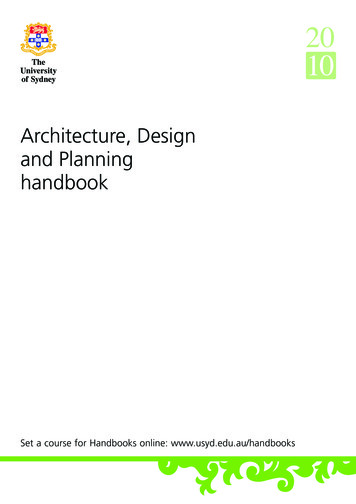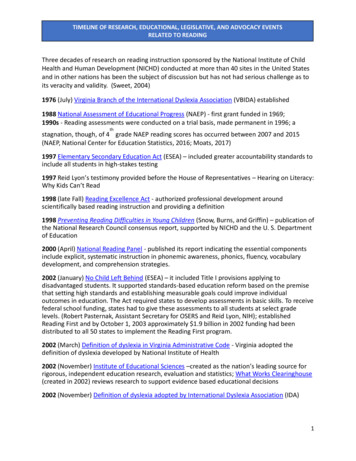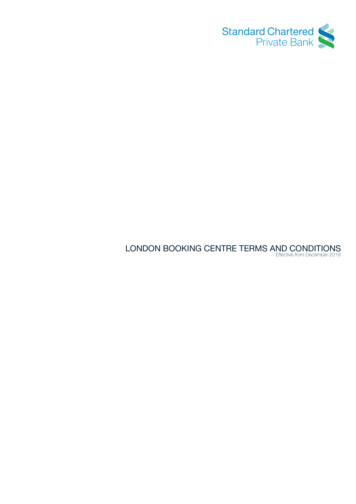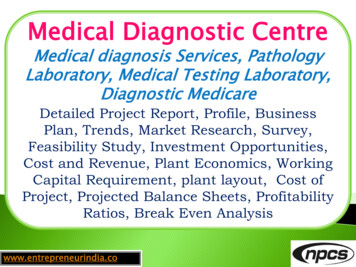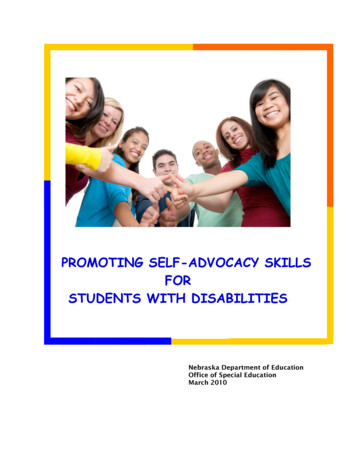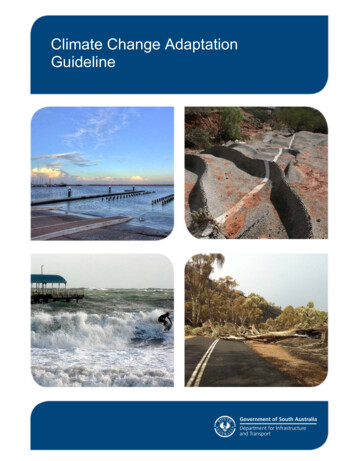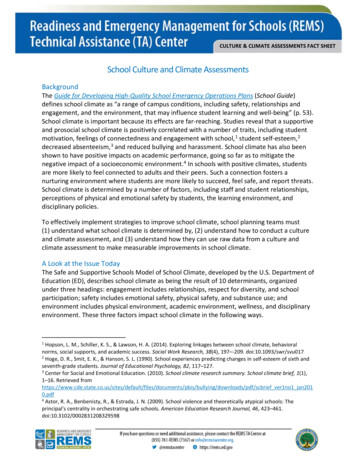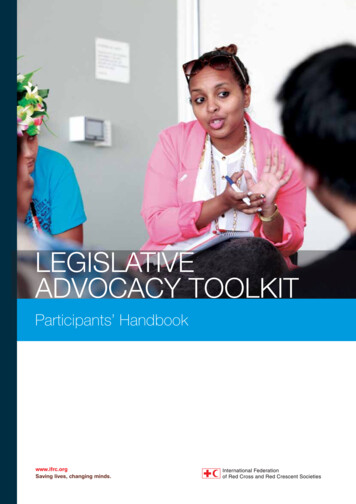
Transcription
LEGISLATIVEADVOCACY TOOLKITParticipants’ Handbook
How we workStrategy 2020 voices the collective determination of the IFRC to moveforward in tackling the major challenges that confront humanity in thenext decade. Informed by the needs and vulnerabilities of the diversecommunities with whom we work, as well as the basic rights andfreedoms to which all are entitled, this strategy seeks to benefit all wholook to Red Cross Red Crescent to help to build a more humane, dignified,and peaceful world.Over the next ten years, the collective focus of the IFRC will be onachieving the following strategic aims:1. Save lives, protect livelihoods, and strengthen recovery fromdisasters and crises2. Enable healthy and safe living3. Promote social inclusion and a culture of non-violence and peace International Federationof Red Cross and Red Crescent Societies,Geneva, 2018Any part of this publication may be cited, copied, translated intoother languages or adapted to meet local needs without priorpermission from the International Federation of Red Cross and RedCrescent Societies, provided that the source is clearly stated. Requestsfor commercial reproduction should be directed to the IFRC atsecretariat@ifrc.org.All photos used in this publication are copyright of the IFRC unlessotherwise indicated.Cover photo: Hala Mohammed Swedish Red CrossInternational Federationof Red Cross and Red Crescent SocietiesRoute de Pré-Bois, 1CH – 1214 VernierSwitzerlandTel. 41 (0)22 730 4836Fax. 41 22 730 4929Web site: http//www.ifrc.org
International Federation of Red Cross and Red Crescent Societies1Legislative Advocacy Toolkit Participants’ HandbookContentsIntroduction2ModulesModule 1 (a)What is advocacy?5Module 1 (b)Understanding and capitalizing on the auxiliary role10Module 2Defining your issue11Module 3The external environment12Module 4Evidence for advocacy13Module 5Developing your advocacy message14Module 6 (a)Elevator pitch16Module 6 (b)Elevator pitch in action17Module 7Credibility and risk18Module 8Who is your target and how to reach them:The influence tree, and working in partnershipsand coalitions20Module 9Using the opposition22Module 10Theory of change23Module 11Planning for success25Module 12 (a)Development of an advocacy strategy26Module 12 (b)Advocacy presentations, feedback and next steps27Module 13Summary and reflections28
2International Federation of Red Cross and Red Crescent SocietiesLegislative Advocacy Toolkit Participants’ HandbookIntroductionThe Legislative Advocacy Toolkit has been designed for use by the IFRC and NationalSocieties to strengthen their legislative advocacy knowledge and skills, and as a resourcefor conducting legislative advocacy trainings. This legislative advocacy training packagefocuses on the “how to”, and provides a step by step guide on how to initiate discussionson advocacy, develop and implement a National Society owned advocacy strategy in asystematic, coherent and engaging way. It is anticipated that this toolkit will be a usefulresource to support a range of advocacy initiatives: not only those led by the IFRC’sDisaster Law Programme (DLP), but by other programmes and departments too.The IFRC’s DLP has been working with National Red Cross and Red Crescent Societiesand key partners for over a decade to advocate, influence and support tangible legal andpolicy change. With DLP teams based in the Americas, Asia Pacific, Africa, and at theglobal level in Geneva, the IFRC has contributed to the development and adoption ofdisaster law procedures in over 30 countries, three regional treaties, and has been activein over 100 countries.National Red Cross and Red Crescent Societies are well-placed in their unique role as‘auxiliary’ to their public authorities in the humanitarian sphere to carry out advocacyactivities in the interests of the most vulnerable. The term ‘auxiliary role’ (meaning tocomplement, supplement or support) will be unpacked as part of this legislative advocacytoolkit. It is a crucial element of National Societies’ positioning, status and ability toinfluence law and policy processes in the national context, yet it is a term which stillrequires de-mystification and a stronger understanding among National Societies and theirpartners, to fully realize and utilize the potential and responsibility that comes with it.The components of the Legislative Advocacy Toolkit, including this Participants’Handbook, were developed by an independent consultant, Jonathan Ellis, with technicalsupport and inputs from the global IFRC DLP team. The new toolkit was trialed at apilot Legislative Advocacy training in Nepal in November 2017, of which the learning,challenges and best practices have been addressed and incorporated into the final toolkit.Course objectivesBy the end of the workshop participants will be able to: Define advocacy Explain the auxiliary role and how it can be leveraged to support National Societyadvocacy Navigate their external policy and advocacy environment, including identification oftargets, coalitions and partners, and how to address / minimize the opposition. Develop an advocacy message Apply a variety of advocacy tools to develop their advocacy strategy Commence discussions and development of an advocacy strategy Understand how they can review their advocacy and sustain momentum Share this learning with colleagues
International Federation of Red Cross and Red Crescent SocietiesLegislative Advocacy Toolkit Participants’ HandbookWhat this course doesThis course sets out a practical definition of legislative advocacy in the context of the RedCross / Red Crescent Movement, and offers a variety of practical tools to help develop anadvocacy strategy. There is a strong emphasis during the course on the importance ofadvocacy planning being based on the reality of the external environment and countrycontext.Throughout the course, there are opportunities for participants to apply the advocacytools on the priority issues identified by their National Societies, and within their owncountry context. At the end of the course there is then the opportunity to consolidate thedifferent approaches and to begin to forge an advocacy strategy.The advocacy strategy grid and template offers participants a road map for developingtheir strategy, and they will be able to record their progress throughout the course as theyengage with each of the advocacy tools. The idea is that participant work together to addbuilding blocks to their advocacy knowledge and skills, and then at the end of the coursethey review these building blocks and pull them together into one cohesive plan to takeforward.What this course does not doThis course will not tell participants which issues to advocate on, or which approachesthey should adopt for their advocacy. Rather, the course will assist participants on howto define their own external environment, how to select their issue, and then how toconstruct an advocacy strategy.This course also does not assume that the National Society will use all the advocacy tools.Rather, the toolkit sets out an advocacy approach, and National Societies are invited toselect which of these tools they see as relevant and helpful in their own national context.Who should do this courseThis course is designed for National Society staff at the leadership and technical levels. Itcan be tailored depending on the level and capacity of the participants. Ideally, participantsshould be the staff or volunteers who are involved in the promotion of legal or policychange, with a mix of leadership, and the relevant technical teams.Pre-requisites for this trainingIdeally, participants will have read the workshop material and any relevant backgroundreading prior to the training. Either as volunteers or staff, they will have a goodunderstanding of the work of their National Society and their operational and policypriorities.They will come to the workshop with an idea of an issue which is confronting theirNational Society and for which they would like to construct an advocacy strategy to findsolution to their issue and the associated ask.3
4International Federation of Red Cross and Red Crescent SocietiesLegislative Advocacy Toolkit Participants’ HandbookUsing this participants’ handbookThis handbook offers a step-by-step approach to help participants develop their ownadvocacy strategy, messages and skills.Each module consists of the following parts: Learning outcomes – what the participant should learn from this session Session content – an overview of the key content and learning in the session. Examples – practical examples will be included on the various advocacy tools to helpbring the learning to life for the participants. Exercises – all the advocacy tools will have a practical exercise(s) to help theparticipants to apply their learning on their own issue and within their own contextsuch as group work and role plays. Materials – if there are additional materials available for participants at the workshopthese will be included here. Further reference – links to additional material from within the Red Cross Red CrescentMovement or more generally on advocacy will be listed here, particularly if they can beaccessed online.In particular, the materials produced by the Global Road Safety Partnership are oftenreferenced. It is suggested that these materials should be used by participants in theirown time at the end of the workshop, as they can be a useful element to consolidatelearning.
International Federation of Red Cross and Red Crescent SocietiesLegislative Advocacy Toolkit Participants’ HandbookModule 1 (a)What is advocacy?Total time 60 minutesLearning outcomeThis introductory session seeks to demystify legislative advocacy and offer clarityaround definitions. It also seeks to explain the full spectrum of advocacy, the differentuse of language and where the Red Cross and Red Crescent sits on this spectrum.Session contentThe first session seeks to define advocacy but also invites participants to think about whyadvocacy is important to them.Advocacy is not a new concept for the Red Cross Red Crescent Movement, and this workshopis building on an established tradition of seeking legal or policy change based on ourhumanitarian experience. Some participants may be familiar with the term ‘humanitariandiplomacy’. Legislative advocacy can be considered as a form humanitarian diplomacy, inthat it seeks to influence opinion leaders and decision makers to act in the interests of themost vulnerable. Many different terms can be used for advocacy, diplomacy, influence etc.In the end, it does not matter what you call it or what terminology you use - but ratherthat you are seeking policy or practice change.Legislative advocacy is focused on achieving legal and policy change at the national andlocal levelThe session also looks at different approaches to advocacy, how legal and policy changehappens and what is needed to be able to undertake advocacy.ExamplesThe cookie story:A good definition of advocacy was explained by a man called Mark Latimer at a conference manyyears ago. After being asked how he would define advocacy, he invited the audience to picture thescene of a small girl at home in her kitchen with her mother.The little girl had a problem: she was hungry. But she knew the solution to her problem: she wanteda cookie from her mother’s cookie jar on the top shelf. She also knew that her mother had the powerto give her one.At first, she tried the direct approach and said, “Mum, Mum, can I have a cookie?” Her mother said,“No”.5DAY 1
6International Federation of Red Cross and Red Crescent SocietiesLegislative Advocacy Toolkit Participants’ HandbookDAY 1She then said, “You gave me a cookie yesterday”, so she was using historic precedent – she was aclever girl. Her mother still said, “No”.ModuleShe then said, “You gave my little brother a cookie.” Her mother again repeated, “The answer is no.”1 (a)She then thought for a while and ran next door to the lounge where her father was watchingtelevision, and said, “Dad, Dad – Mum won’t give me a cookie.”And that story is the most basic yet effective definition of advocacy I have ever heard. The little girlwas: clear on the problem, she was very clear on the solution to that problem, she was also very clear who had the power to make the change she wanted to see and she then sought to influence that person.Critical to this story is her focus and persistence – she didn’t give up despite her initial failure.Materials / handouts:Handout 1: Six theories on how policy change happensPathways for change: six theories of how policy change happens - Organizational ResearchServicesReflecting on the six theories on how policy change happens in your group discuss whichtheory relates to each scenario below: The government announces an end to the detention of children for immigrationpurposes, but the detention of adults remains in place The relaxation of travel restrictions in East Berlin leading to the collapse of the BerlinWall Contract cleaners working together to put pressure on their employer to pay them adecent living wage The National Society is invited to meet the Government Minister to make the case fora new Red Cross Law Organizations come together from across Civil Society to make the case for First Aid tobe taught in schools The National Society begins to consider whether its public messages on the need forpolicies to strengthen resilience are really understood by the government
International Federation of Red Cross and Red Crescent SocietiesLegislative Advocacy Toolkit Participants’ HandbookHandout 2: Legislative Advocacy Strategy Planning Grid7DAY 1The legislative advocacy strategy grid is designed to help participants take note of theirlearning throughout the workshop.ModuleLegislative Advocacy Strategy Planning Grid1 (a)1. What is advocacy and why is itimportant to you?2. What is your issue? But why is it anissue?3. Is there a common understanding ofyour external environment?4. What evidence have you got or do youneed?5. What is your advocacy message?What are you trying to change?6. Can you do the elevator pitch?7. How credible are you and what are therisks?8. Do you know who your target is andhow to reach them? Which partners /allies / coalitions could you work with?9. How are you using the opposition tohelp you?10. Have you got a theory of change?11. Have you got a plan for success?12. When and how are you going to reviewprogress?
8DAY 1Module1 (a)International Federation of Red Cross and Red Crescent SocietiesLegislative Advocacy Toolkit Participants’ HandbookHandout 3:Legislative Advocacy Strategy TemplateIntroductionThis template for building a legislative advocacy strategy provides the framework for sucha strategy and suggests the key questions that you will need to answer. This templateis designed to complement the Legislative Advocacy grid and to help begin to draft theadvocacy strategy.1. Defining advocacy for your National SocietyWhat does advocacy mean for your National Society and what is the link with theauxiliary role?2. Defining your advocacy issueWhat is your issue?Be clear about why you have selected your issue. Think about: Experience and evidence Clear solution ‘Win-ability’ Views of service users Interest from targetBut why is it an issue?3. The external environment for advocacyWhat is your common understanding of your external environment?Think about: How does change happen in your society? Where does power lie in your society? And with regards to your issue?4. The evidence for advocacyWhat evidence have you got or do you need?Think about: What evidence of your problem do you have? What do the ‘but why’ questions tell you that you need for evidence? Does the evidence already exist? Rapid and revealing – ideally macro and micro – numbers and human stories Who is going to do it – you / an ally / or someone independent?
International Federation of Red Cross and Red Crescent SocietiesLegislative Advocacy Toolkit Participants’ Handbook5. Defining your advocacy messageWhat is your advocacy message?Remember the three-stage approach: Firstly, your message needs to engage and capture the interest of your target Secondly you need to show your target that change is possible and that they can do somethingto make this change And finally, you need to make a request or an ‘ask’ of them6. The elevator pitch for your advocacy messageWhat is your elevator pitch? (Use the elevator pitch handout)Think about: Your introduction How you describe the issue How you describe your solution What your ask is7. Your credibility and the potential risks with your advocacyHow credible are you and what gives you the legitimacy to advocate on your issue?What are the risks? (Use the risk register template)8. Your advocacy targetDo you know who your target is, how to reach them and who influences them? Whichpartners / allies / coalitions could you work with? (Use the influence tree template)9. The opposition to your advocacyHow are you using opposition to help you? (Use the opposition matrix template)10. Developing a theory of change for your advocacyHave you got a theory of change? (Use the theory of change template)Think about the immediate small steps you need to take, and also the bigger steps overtime to help you reach your goal.11. Plan for successWhat is your plan for dealing with your advocacy success?12. Reviewing your advocacy strategyWhen and how are you going to review progress?Further reference2009 IFRC Humanitarian Diplomacy policy9DAY 1Module1 (a)
10DAY 1International Federation of Red Cross and Red Crescent SocietiesLegislative Advocacy Toolkit Participants’ HandbookModule 1 (b)Understanding and capitalizing on the auxiliary roleTotal time 90 minutesLearning outcomeFor participants to gain a deeper understanding of their auxiliary role, what it meansand the associated roles and responsibilities. Participants should feel comfortableexplaining the auxiliary role and how to harness it to undertake legislative advocacy.Session contentThe session will guide participants through the auxiliary role from the formal definition,to an awareness that the auxiliary role can be shaped in different ways, in differentcountries, by different factors.The critical point is that the auxiliary role defines the relationship between the governmentand National Society and establishes it as the space for dialogue and for a two-wayrelationship. In essence, the auxiliary role is the backbone for legislative advocacy as itprovides a seat at the table. The challenge is: how can we best utilize and harness thisposition for the purposes of legislative advocacy?You will be asked to reflect on the following questions:1. What is your understanding for the auxiliary role in your country?2. Where has it / or has it not been applied, and why?3. How is the auxiliary role perceived externally in your country?Further reference31st International Conference of the Red Cross and Red Crescent background report:Furthering the auxiliary role: Partnership for stronger National Societies and volunteeringdevelopment30th International conference of the Red Cross and Red Crescent background document:The specific nature of the Red Cross and Red Crescent Movement in action and partnerships and therole of National Societies as auxiliaries to the public authorities in the humanitarian field.IFRC Fundamental Principles leaflet
International Federation of Red Cross and Red Crescent SocietiesLegislative Advocacy Toolkit Participants’ HandbookModule 2Defining your issueTotal time 30 minutesLearning outcomeThis session seeks to help participants to select their advocacy issue and then introducesa tool to help them understand their problem and make sure that they are aware of theroot cause of the problem - not just the superficial cause.Session contentThis session emphasizes the importance of having a clear focus in advocacy. The enemyof effective advocacy is a lack of focus.The session explores how you might use selection criteria to choose your advocacy issueand introduces an advocacy tool called the ‘but why?’ technique, to help you to get to thevery root of your issue.Further referenceSetting policy priorities – Global Road Safety Campaign (A detailed step by step guide forprioritizing your issues and developing your advocacy message)11DAY 1
12DAY 1International Federation of Red Cross and Red Crescent SocietiesLegislative Advocacy Toolkit Participants’ HandbookModule 3The external environmentTotal time 60 minutesLearning outcomeFor participants to explore the realities of their own external environment and countrycontext, and to share assumptions and to come to a common understanding of theexternal environment as the context for their advocacy. Participants will understandthe central importance of rooting their advocacy in the realities of their own externalenvironment.Session contentThere are four key elements to this module: to think about how change happens in society,where power lies, how things have been changed in the past, and for the participants toreflect on what they know about their external environment.Further referencePolitical mapping ‘How to’ Guide – Global Road Safety Campaign (A detailed framework forproducing a political map for your advocacy).
International Federation of Red Cross and Red Crescent SocietiesLegislative Advocacy Toolkit Participants’ HandbookModule 4Evidence for advocacyTotal time 30 minutesLearning outcomeFor participants to understand the importance of evidence to support advocacywith the warning that research can be a ‘handbrake’ on dynamic advocacy. To helpparticipants think about their evidence needs, there are key questions to drive evidencefor advocacy.Session contentThis session focuses on the importance of evidence for advocacy. There are key questionsoffered to you, which are designed to help you think about what you may need in terms ofevidence, but also to challenge you to assess whether the evidence already exists withinor outside your organization.Further referenceBritish Red Cross, Not so straightforward (2015). (A review of the impact of the withdrawalof publicly funded legal support for refugee family reunion in the UK).13DAY 1
14International Federation of Red Cross and Red Crescent SocietiesLegislative Advocacy Toolkit Participants’ HandbookModule 5Developing your advocacy messageDAY 1Total time 30 minutesLearning outcomeFor participants to understand how to construct an advocacy message, focusing on theproblem and the solution.Session contentThe session focuses on how to construct an advocacy message and the importance offocus and clarity. Once communicated, your target needs to be 100% certain as to whatyour message is: there should be no ambiguity.Materials / handouts:Handout 4: Good or Bad advocacy messagesReflect on the following advocacy messages, intended for the relevant publicauthorities; do you think that they are examples of good or bad practice in developingan advocacy message? We are concerned that only one in five students get a chance to learn first aid inschools. We want to see a generation of life-savers come through our nation’s schools.Will you meet with us to discuss how we might work together to make that happen? We think the country is ill prepared for a natural disaster. We want to know what youare going to do to make us all better prepared. We are concerned that refugees are struggling to be re-united with their families dueto the lack of legal support. We know that these cases are complex and they can onlybe re-united with legal support. Would you read our report that shows how the RCRCcan work with you to ensure more people can be re-united with their families? We are worried about the high levels of conflict in our society. We cannot afford to donothing – future generations are relying on us. What are you going to do to tackle thisissue? Poverty is at record levels in our country – it is just not sustainable. We need real actionand not just words. What are you going to do to tackle this issue? The RCRC is uniquely placed to assist public authorities to respond to crises thoughour auxiliary role. However, many officials that we work with don’t know about ourauxiliary role. Would you meet with me to discuss how we might champion the needfor a new RCRC Act so that we have a legal base for our work, and to support the publicauthorities?
International Federation of Red Cross and Red Crescent Societies15Legislative Advocacy Toolkit Participants’ HandbookFurther referenceTalking with policy makers – Global Road Safety Campaign (Useful practical advice before,during and after meeting policy makers)Guide to the Auxiliary role of Red Cross Red Crescent National Societies, available for theAfrica, Americas, Asia Pacific, Middle East and North Africa regions.DAY 1Module5
16DAY 1International Federation of Red Cross and Red Crescent SocietiesLegislative Advocacy Toolkit Participants’ HandbookModule 6 (a)Elevator pitchTotal time 45 minutesLearning outcomeFor participants to be able to construct a 15 to 30 second pitch which conveys theessence of their advocacy message including both their problem and their solution.Session contentThis session introduces another advocacy tool – the elevator pitch. How can you mosteffectively communicate your advocacy message in 15-30 seconds? This tool is the basicbuilding block for your advocacy.Elevator pitch considerations:ProblemSolutionAskWhat is the problem?Why is it a problem?What is the solution?How do you know itwill work?What is your ask?ExamplesHi! I’m X from the Red Cross. We are concerned that at best only one in five schools teach theirchildren basic first aid techniques. We don’t think that’s enough. We’d like to see every child giventhe chance to learn first aid so that we see a generation of lifesavers. We think we could do more.Would you meet with me to discuss how we might make this happen?Materials / handouts:Handout 5: Elevator pitch templateKey points to consider:As you begin to construct your succinct elevator pitch, think about the followingquestions:1. How will you introduce yourself?2. How will you set out your advocacy problem?3. How will you explain your desired solution?4. What do you want from your target – what is your immediate ask?
International Federation of Red Cross and Red Crescent SocietiesLegislative Advocacy Toolkit Participants’ HandbookModule 6 (b)Elevator pitch in actionTotal time 30 minutesLearning outcomeFor participants to feel more confident in constructing and delivering their elevatorpitch on their chosen issue.Session contentThis is an opportunity to further develop your elevator pitch. You might want to considersome different target audiences and how you could modify your pitch if you were speakingto the following audiences, for example: Government minister – you know that they have the power and influence so your aimis to get their interest and understanding as to why they should get involved in yourissue. Opposition politician – they will not have the power but they might be helpful inraising the issue from another perspective. Potential ally or partner organization / alliance – you will want to interest them andshow them how their support would be useful to your advocacy work and why thiswould be of interest or benefit to them e.g. it may be relevant to a related project orpriority area of work. The business leader – if you could get their interest, s/he could be a surprising ally foryour advocacy. You need to be thinking – how is my issue relevant to their agenda?17DAY 2
18DAY 2International Federation of Red Cross and Red Crescent SocietiesLegislative Advocacy Toolkit Participants’ HandbookModule 7Credibility and riskTotal time 60 minutesLearning outcomeFor participants to reflect on what gives their National Society credibility to speak outon a particular issue, on the risks associated with advocacy and what can be done toreduce those risks. Above all, for participants to be able to embrace risk as an essentialpart of the management of their advocacy.Session contentThe first part of the session looks at credibility for National Society advocacy. You will beinvited to consider what gives a National Society credibility to speak out and where theyget their mandate from.The second part of the session looks at risk and encourages you to see risk as a centralpart of undertaking advocacy. When developing an advocacy strategy, you should includea risk register in your strategy and this risk register needs to be reviewed on a regular basisExamplesAt the British Red Cross, they are clear that their credibility to speak out on refugee issuescame from their operational experience on the ground supporting refugees in 60 locationsacross the UK. They maintained that this operational footprint and their interaction withtheir service users gave them a mandate to speak out.An example of a risk register for advocacyRiskLikelihood(1 low – 4 high)Impact(1 low – 4 high)Action to reduce theriskAdvocacy issue isembraced by justone political party24Ensure there isengagement with all thepolitical partiesLack of supportfrom ownsupporters foradvocacy issue13Ensure regularcommunication withsupporters in run-up tolaunch and then ongoing responses to anyconcerns
International Federation of Red Cross and Red Crescent Societies19Legislative Advocacy Toolkit Participants’ HandbookRiskLikelihood(1 low – 4 high)Impact(1 low – 4 high)Action to reduce theriskAttack in the mediaabout the advocacy24Develop good network ofallies who will be readyto speak out publicly indefence of the campaignBreach orperceived breachof FundamentalPrinciples24Ensure mandate and roleof the NS to speak outon the advocacy issueis clear, and that alliesand target audiencesknow and understandthis. Ensure advocacymessages are clearlybased on the NS mandateand position.Materials / handouts:Handout 6: Risk re
nternational ederation of Red ross and Red rescent Societies 3 Legislative Advocacy Toolkit Participants’ Handbook What this course does This course sets out a practical definition of legislative advocacy in the context of the Red Cross / Red Crescent Movement, and offers a variety
